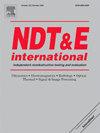Broadband nonlinear RAPID: a baseline-free probabilistic imaging approach for single-defect localization using a sparse sensor network
IF 4.5
2区 材料科学
Q1 MATERIALS SCIENCE, CHARACTERIZATION & TESTING
引用次数: 0
Abstract
Guided wave imaging is capable of efficiently inspecting large-scale samples and localizing defects by using a sparse sensor network. One of the most popular guided wave imaging implementations is the Reconstruction Algorithm for Probabilistic Inspection of Defects (RAPID). Yet, the conventional RAPID method requires a baseline, rendering it impractical under varying environmental or operational conditions.
This paper introduces the Broadband Nonlinear Reconstruction Algorithm for Probabilistic Inspection of Defects (BB-NL-RAPID) method, a baseline-free approach exploiting the lack of amplitude scalability induced by nonclassical nonlinearity at defects. Two sets of broadband sweep sine signals with different amplitudes are injected into a sparse sensor network to activate a multitude of nonlinear wave/defect interactions. The scaling subtraction method is employed to extract the resulting residual signal. The extracted broadband residual signal is then filtered and decomposed into a set of tone burst residual responses in the fundamental input frequency range, from which corresponding narrowband NL-RAPID damage maps are constructed. An automated estimation framework is implemented to extract the group velocity of the first arrival wave packet. Finally, a merging strategy based on principal component analysis is introduced to fuse all narrowband damage maps into a single BB-NL-RAPID damage map.
The proposed BB-NL-RAPID approach is first numerically illustrated on a simulated dataset using 3D finite element method which is representative for a carbon fiber reinforced polymer (CFRP) with a kissing bond defect. The performance of the proposed BB-NL-RAPID method is quantified for (i) different signal-to-noise ratios, (ii) number of cycles in the tone burst decomposition and (iii) range of shape factors β. Experimental demonstration of the BB-NL-RAPID method is performed on a CFRP plate containing a barely visible impact damage, and on a stiffened CFRP A320 component with a disbond defect.
宽带非线性RAPID:利用稀疏传感器网络进行单缺陷定位的无基线概率成像方法
导波成像利用稀疏传感器网络,能够有效地检测大尺度样品,并对缺陷进行定位。最流行的导波成像实现之一是缺陷概率检测重构算法(RAPID)。然而,传统的RAPID方法需要一个基线,使得它在不同的环境或操作条件下不切实际。本文介绍了用于缺陷概率检测的宽带非线性重建算法(BB-NL-RAPID)方法,这是一种利用缺陷非经典非线性导致的振幅可扩展性不足的无基线方法。将两组不同幅值的宽带扫描正弦信号注入到稀疏传感器网络中,激活大量的非线性波/缺陷相互作用。采用尺度减法提取残差信号。然后对提取的宽带残差信号进行滤波,分解为基频输入范围内的一组音突发残差响应,并以此构建相应的窄带NL-RAPID损伤图。实现了一种自动估计框架来提取首到波包的群速度。最后,提出了一种基于主成分分析的融合策略,将所有窄带损伤图融合为一张BB-NL-RAPID损伤图。本文首先利用三维有限元方法在模拟数据集上对BB-NL-RAPID方法进行了数值说明,该方法代表了具有亲和键缺陷的碳纤维增强聚合物(CFRP)。对所提出的BB-NL-RAPID方法的性能进行了量化(i)不同的信噪比,(ii)音调突发分解的周期数和(iii)形状因子β的范围。BB-NL-RAPID方法的实验演示在CFRP板上进行,其中包含几乎不可见的冲击损伤,以及带有脱粘缺陷的CFRP A320加筋组件。
本文章由计算机程序翻译,如有差异,请以英文原文为准。
求助全文
约1分钟内获得全文
求助全文
来源期刊

Ndt & E International
工程技术-材料科学:表征与测试
CiteScore
7.20
自引率
9.50%
发文量
121
审稿时长
55 days
期刊介绍:
NDT&E international publishes peer-reviewed results of original research and development in all categories of the fields of nondestructive testing and evaluation including ultrasonics, electromagnetics, radiography, optical and thermal methods. In addition to traditional NDE topics, the emerging technology area of inspection of civil structures and materials is also emphasized. The journal publishes original papers on research and development of new inspection techniques and methods, as well as on novel and innovative applications of established methods. Papers on NDE sensors and their applications both for inspection and process control, as well as papers describing novel NDE systems for structural health monitoring and their performance in industrial settings are also considered. Other regular features include international news, new equipment and a calendar of forthcoming worldwide meetings. This journal is listed in Current Contents.
 求助内容:
求助内容: 应助结果提醒方式:
应助结果提醒方式:


